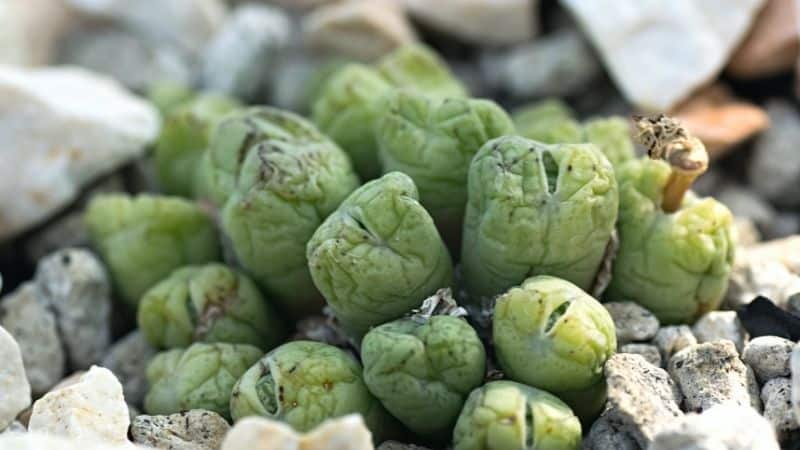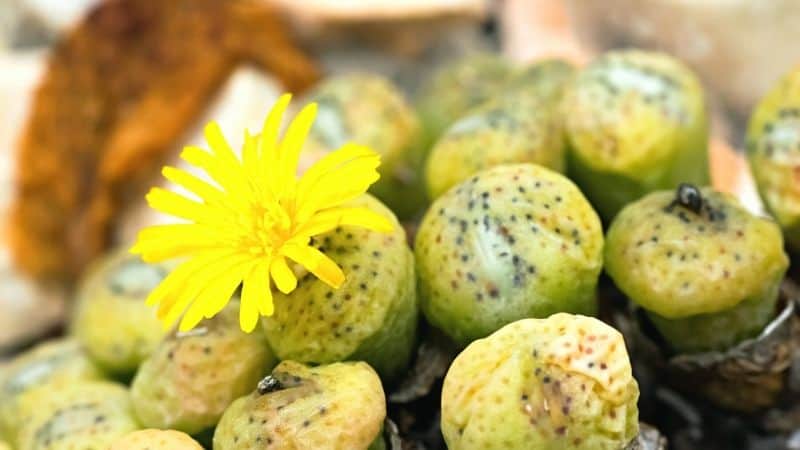Conophytum is a small succulent that grows in a dense cluster. The plant is highly sought-after by succulent enthusiasts thanks to its miniature size and bright yellow or purple flowers. These little plants sprout dense leaves that often grow in heart-shaped pairs.
Conophytum Care Guide Overview
- How To Plant (when & where)
- How To Grow (staking, watering, fertilizing, humidity, mulching)
- How To Trim And Prune
- How To Pot And Repot
- How To Propagate (when & how)
- And Pests and Diseases, Plant Species, Companions, Toxicity
Characteristics
- Scientific Name and Common Names: Conophytum pageae, commonly known as Conophytum, cone plants, dumplings, knopies, and living pebbles
- Origin: Namibia and South Africa
- Indoor or Outdoor plant: Indoors except for warmer regions
- Height and Structure: One inch tall.Grows into a dense mound formed of thick leaves.
- Temperature: Can withstand temperatures as low as 35 degrees Fahrenheit.
- Flower Color: Purple or yellow
How To Plant a Conophytum

Planting Time
When it’s kept as an indoor plant, Conophytum can be planted at any time. However, it’s often best to plant or repot just before the plant restarts its active growth period. This is usually in late summer or early fall when the older leaves of the plants shed away.
Spacing
When grown outside of a pot, Conophytum can spread up to 2 feet. For this reason, if the plant is grown in a garden, it’s a good idea to offer plenty of space between it and any other plants.
Light
These plants require a large amount of light, but their delicate leaves are prone to sunburn. To balance their light needs, it’s best to place a Conophytum in an area that gets direct sunlight only during the coolest parts of the day, such as early morning and evening. These plants tend to lean toward the sun, so you may be able to tell if the plant needs more light simply by observing how the leaves stretch.
Soil
As a succulent, Conophytum does best when placed in well-draining soil. Cactus or succulent potting mixes are a good choice.
How To Grow a Conophytum

Growth Habits
Conophytum stays low to the ground, only growing to about 1 inch tall, but, if given enough room, it can spread to 2 feet wide. These plants go dormant during warmer weather in the spring and summer and begin growing again during the fall, continuing through winter. When the plant gets ready to begin its growth cycle, it will shed many or all of its old leaves. These leaves will form a papery wrapper that protects the new leaves as they grow.
Watering
Conophytum should be watered according to its growth cycle. During the spring and summer, when it’s dormant, the plant should be watered very little, if at all. During the growth cycle, water the plant well, soaking the soil, but allow the soil to dry out completely between each watering.
Fertilizing
Conophytums rarely need fertilizing. The only time the plant should be fed is after repotting, just before the new growth cycle. Feed with a very gentle, low nitrogen fertilizer. It’s best to dilute fertilizers by at least half.
Humidity
Conophytums do best in medium to low humidity environments. If the plant is kept in a humid climate, ensure that there’s plenty of airflow around the plant.
Trimming and Pruning
Conophytum plants rarely need any pruning, but they can be divided by gently breaking away leaf pairs in order to keep the plants from spreading too much.
Pot And Repotting
Conophytums can be kept in pots as small as 2 to 4 inches in diameter. The plants grow slowly, so the need to repot is rare and should only be done every two years or so. Choose a pot, such as a ceramic pot, that dries out quickly and has plenty of drainage.
Propagation
These plants can be grown easily from seeds. Plant the seeds in succulent or cactus soil in the fall and cover the seeds with a thin layer of sand. It’s important to keep the seeds moist until they germinate, which usually takes between two and four weeks.
Divide And Transplant
Conophytums can also be easily propagated by division. When repotting, carefully break away leaf pairs in clusters of two to four pairs. Repot the new clusters and keep them moist until they’re established. It’s best to divide and repot this plant just before the growth season.
Pests And Diseases
Conophytums are hardy plants when it comes to pests or diseases. Most pests leave the plant alone, but mealybugs will sometimes attack the plant’s roots. This problem can be solved with the use of a gentle insecticide, applied once during the fall.
Conophytum isn’t prone to diseases, although root rot can sometimes become a problem if the plant is overwatered. To keep the plant healthy, trim away any dead flowers and water only once the soil has completely dried.
Plant Species
There are many Conophytum varieties available, each with its own coloring and patterns. Conophytum obcordellum, for example, has a blueish coloration with dark blue-green spots. Conophytum bilobum are some of the most recognizable Conophytums, as their bright green leaves grow into a distinct heart shape. Conophytum minimum, on the other hand, has a shorter, rounder shape, with purple veining over a light green leaf.
Companions
As a potted indoor plant, Conophytum works well with a variety of other plants. It could be set in a display with other succulents or plants that enjoy a similar amount of light. Taller plants also make an excellent backdrop for this plant.
If Conophytum is planted outside, remember to plant it in an area with bright, cool light and fast-draining soil. Any other plants, such as cacti or other succulent varieties that appreciate the same environment, will work well with Conophytum.
Toxicity
Is the plant toxic?
Conophytum is not toxic to humans.
Is it toxic for cats or dogs?
Conophytum is a non-toxic plant and is considered both dog and cat safe.


